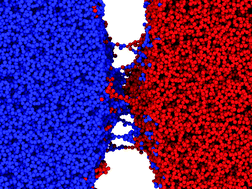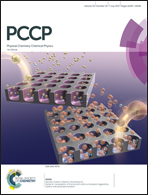The bouncing threshold in silica nanograin collisions
Abstract
Using molecular dynamics simulations, we study collisions between amorphous silica nanoparticles. Our silica model contains uncontaminated surfaces, that is, the effect of surface hydroxylation or of adsorbed water layers is excluded. For central collisions, we characterize the boundary between sticking and bouncing collisions as a function of impact velocity and particle size and quantify the coefficient of restitution. We show that the traditional Johnson–Kendall–Roberts (JKR) model provides a valid description of the ingoing trajectory of two grains up to the moment of maximum compression. The distance of closest approach is slightly underestimated by the JKR model, due to the appearance of plasticity in the grains, which shows up in the form of localized shear transformation zones. The JKR model strongly underestimates the contact radius and the collision duration during the outgoing trajectory, evidencing that the breaking of covalent bonds during grain separation is not well described by this model. The adhesive neck formed between the two grains finally collapses while creating narrow filaments joining the grains, which eventually tear.



 Please wait while we load your content...
Please wait while we load your content...